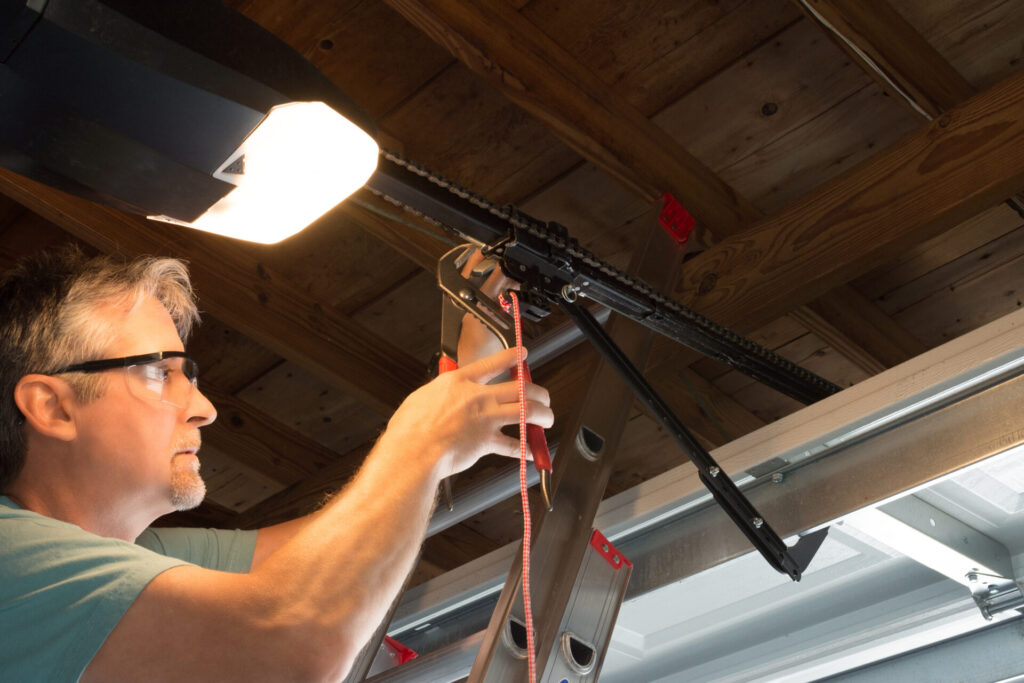Common Garage Door Repair Issues: When to DIY vs. Call the Professionals
Expert Solutions for Garage Door Problems Texas Homeowners Face Every Day
When your garage door starts acting up, it can throw your entire routine into chaos—especially during those hot Texas summers when your garage provides essential climate-controlled storage and convenient home access. At Texas Garage Door and Opener, we understand the frustration of dealing with malfunctioning garage doors, which is why our highly trained and experienced technicians specialize in diagnosing and repairing the full spectrum of garage door issues that plague homeowners across the Lone Star State. From broken springs and misaligned tracks to faulty openers and sensor malfunctions, we’ve seen it all and know exactly how to fix it safely and efficiently. With garage doors cycling thousands of times each year while lifting and lowering doors that often weigh several hundred pounds, it’s no wonder that mechanical issues arise—but knowing which problems you can tackle yourself and which require professional intervention can save you time, money, and potential injury. Our commitment goes beyond just fixing immediate problems; we focus on identifying underlying issues that could lead to future breakdowns, ensuring your garage door system operates reliably for years to come. Whether you’re dealing with a door that won’t open on a busy Monday morning or strange noises that keep you awake at night, our team brings the expertise and dedication needed to restore your garage door to peak performance.

Understanding Your Garage Door System
Before diving into specific repair issues, it’s important to understand that your garage door is a complex mechanical system with multiple interconnected components that must work in harmony. The average garage door weighs between 125-200 pounds for single doors and up to 400 pounds for double doors, making proper operation dependent on precisely balanced springs, smooth-running tracks, and reliable opener mechanisms.
Key Components Overview includes the door panels themselves, which are typically made up of several hinged sections that bend as they move along the tracks. The counterbalance spring system—either torsion springs mounted above the door or extension springs along the sides—does the heavy lifting by offsetting the door’s weight. Rollers guide the door along tracks, while cables connect the springs to the door panels to distribute lifting force evenly.
The Role of Your Opener extends beyond simply pushing a button on your remote. Modern garage door openers include safety features like automatic reversal systems, infrared sensors that detect obstructions, and rolling code technology that prevents unauthorized access. When any part of this system fails, it can affect the entire operation and potentially create safety hazards.
Texas Climate Considerations play a significant role in garage door performance. Our extreme heat can cause metal components to expand, affecting track alignment and door balance. Sudden temperature changes during winter months can make lubricants thicken and cause increased resistance in moving parts. Understanding these environmental factors helps explain why certain problems occur more frequently in our region.
Opener Issues: Motor and Drive System Problems
Garage door opener problems rank among the most common issues we encounter, often manifesting as doors that won’t respond to remote commands, make unusual noises, or operate inconsistently. These motorized systems work incredibly hard, and various components can fail over time.
Motor and Drive System Failures typically present as doors that attempt to move but struggle or stop mid-cycle. Chain drive systems may develop stretched or broken chains, while belt drives can snap or slip. Screw drive systems, popular for their simplicity, can wear down the threaded rod over time. When you hear the motor running but the door doesn’t move, the problem usually lies within the drive mechanism itself.
Circuit Board and Electrical Issues affect the opener’s ability to receive and process commands from remotes, wall switches, and safety sensors. Power surges, age, and moisture can damage these sensitive electronic components. Signs of circuit board problems include erratic behavior, failure to respond to any commands, or lights that won’t turn on despite having power to the unit.
Sensor Problems and Safety Concerns involve the infrared photo-eye sensors positioned near the garage floor. These safety devices prevent the door from closing on people, pets, or objects. Misalignment is the most common issue—often caused by bumping during yard work or settling of the garage structure. Dirty sensors, sun interference at certain times of day, or damaged wiring can also prevent proper operation.
Remote Control Malfunctions frustrate homeowners but are often the easiest opener issues to resolve. Dead batteries account for the majority of remote problems, followed by programming issues when remotes lose their connection to the opener. Signal interference from other devices or damaged antennas on the opener unit can also disrupt communication.
Door Hardware Problems: Springs, Rollers, and Tracks
The mechanical components that physically move your garage door endure tremendous stress and wear, making them prone to various failure modes that can affect operation and safety. These problems often develop gradually but can become dangerous if left unaddressed.
Broken Springs: A Dangerous Situation represent one of the most serious garage door problems homeowners face. Garage door springs are under extreme tension—torsion springs can exert hundreds of pounds of force, making them extremely dangerous to handle without proper tools and training. When springs break, they often do so suddenly and with a loud bang that can be heard throughout the house. A broken spring typically prevents the door from opening manually or causes the opener to struggle and potentially fail.
Worn and Broken Rollers create noise and operational problems that gradually worsen over time. Steel rollers with ball bearings last longest but require regular lubrication, while nylon rollers run quieter but may crack or chip, especially in extreme temperatures. When rollers wear out, you’ll notice increased noise, rough operation, or the door binding in the tracks.
Track Alignment and Damage Issues occur when the metal tracks that guide the door become bent, warped, or knocked out of alignment. Even small misalignments can cause the door to bind, operate unevenly, or create excessive wear on rollers and other components. Damaged tracks often result from impact—such as backing into the door or objects falling against the tracks.
Cable Problems typically occur in conjunction with spring issues, as the cables that connect springs to the door experience similar stress levels. Frayed, stretched, or broken cables can cause the door to hang at an angle or drop suddenly, creating a significant safety hazard that requires immediate professional attention.
Panel and Weather Protection Issues
Garage door panels and weather sealing components face constant exposure to Texas weather extremes, making them susceptible to various forms of damage that affect both appearance and functionality. These problems may seem cosmetic but can lead to more serious issues if ignored.
Panel Damage from Impact and Weather commonly occurs from vehicles, sporting equipment, or falling tree branches. Dented or cracked panels not only affect your home’s curb appeal but can also disrupt the door’s balance and smooth operation. In many cases, individual panels can be replaced without requiring a complete door replacement, but this work requires careful measurement and professional installation to maintain proper door balance.
Weatherstripping Deterioration becomes problematic as seals dry out, crack, or pull away from the door. This deterioration allows hot Texas air, dust, insects, and moisture to enter your garage, reducing energy efficiency and potentially damaging stored items. Bottom seals take the most abuse from constant contact with the floor and seasonal temperature changes.
Insulation Issues affect both energy efficiency and noise levels. Older doors may have deteriorating insulation, while newer doors might suffer damage to insulated panels. Poor insulation becomes especially noticeable during extreme Texas temperatures, when garages become unbearably hot or lose conditioned air rapidly.
Safety System Failures and Warning Signs
Modern garage doors incorporate multiple safety features designed to prevent injury and property damage. When these systems malfunction, immediate attention is required to restore safe operation and prevent accidents.
Automatic Reversal System Problems prevent the door from reversing direction when it encounters resistance while closing. This safety feature prevents crushing injuries and property damage, making its proper operation essential. Problems with force settings, mechanical obstructions, or sensor issues can prevent proper reversal operation.
Unbalanced Door Movement indicates problems with the spring system or track alignment that create safety hazards and accelerate wear on other components. An unbalanced door may close too quickly, open unevenly, or require excessive force from the opener to operate. Testing door balance by disconnecting the opener and manually lifting the door reveals whether the mechanical system is properly adjusted.
Excessive Noise During Operation often signals developing problems before they become serious failures. Grinding noises suggest worn rollers or damaged tracks, while squeaking indicates insufficient lubrication. Loud banging or sudden noise changes can indicate immediate safety concerns that require professional evaluation.
When to Call Texas Professionals vs. DIY Solutions
Understanding which garage door problems you can safely address yourself versus those requiring professional intervention helps you make informed decisions that protect both your safety and your wallet. Some issues are simple maintenance tasks, while others involve dangerous components that can cause serious injury.
Safe DIY Tasks include replacing remote control batteries, cleaning sensor lenses, lubricating hinges and rollers with appropriate garage door lubricant, and clearing minor obstructions from tracks. These maintenance tasks help prevent more serious problems and can often resolve minor operational issues.
Professional-Only Repairs include anything involving springs, cables, or tracks under tension, as well as electrical work on opener circuits, major track realignment, and panel replacement. These components can cause serious injury due to the extreme forces involved or electrical hazards present in opener systems.
Emergency Situations require immediate professional attention and include broken springs, doors that have fallen or are hanging at angles, severely damaged tracks that prevent operation, and any situation where the door poses an immediate safety risk. These problems should never be ignored or attempted as DIY repairs.
Preventive Maintenance Benefits cannot be overstated in extending your garage door’s lifespan and preventing costly emergency repairs. Regular professional inspections can identify developing problems before they cause failures, while proper maintenance keeps all components operating smoothly and safely.
The key to successful garage door ownership lies in understanding your system’s complexity and respecting the safety hazards involved. While some minor issues can be addressed with basic tools and knowledge, the majority of garage door problems require professional expertise to resolve safely and effectively.
Experiencing garage door problems that are disrupting your daily routine? Don’t risk your safety or make the problem worse—contact Texas Garage Door and Opener today for fast, professional diagnosis and repair. Our experienced technicians are ready to restore your garage door to reliable operation, ensuring your family’s safety and your peace of mind.
